As fungi, mushrooms come in different hues. One type of mushroom that is particularly eye-catching is the blue mushroom. These mushrooms have an almost unreal shade of blue and are found across the world in different climates and terrains.
Some common blue fungi include blue oysters, entoloma hochstetteri, lactarius indigo and blue chanterelles.
While many types of mushrooms are edible, some blue mushrooms are inedible and should not be consumed. Below we’ll discuss how to identify, how to find and more.
List of Blue Mushrooms
1. Blue Oyster Mushroom
Blue oyster mushrooms are one of the easiest to cultivate. Like other oysters, they are popular because of their chicken-like flavor and also because their texture remains intact in various types of cooking.
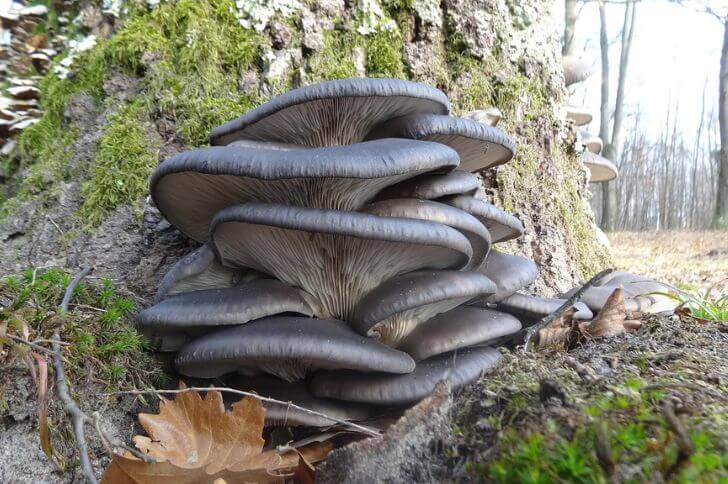
Identification:
To identify blue oyster mushrooms, first check the cap. It is typically blue-gray and can range in size from 2 to 8 inches in diameter.
It is usually convex when young, becoming more flat or funnel-shaped as it matures. Underneath you’ll spot decurrent gills; they run down the stem. They are typically white or cream-colored, becoming grayish as the mushroom ages.
How can you use blue oysters? There are various ways you can cook these blue mushrooms.
From sauteing to braising to grilling, oysters are incredibly versatile. Also, they pair well with other mushrooms and herbs such as sage, thyme and parsley. Fresh blue oysters can last up to three days refrigerated.
2. Entoloma Hochstetteri
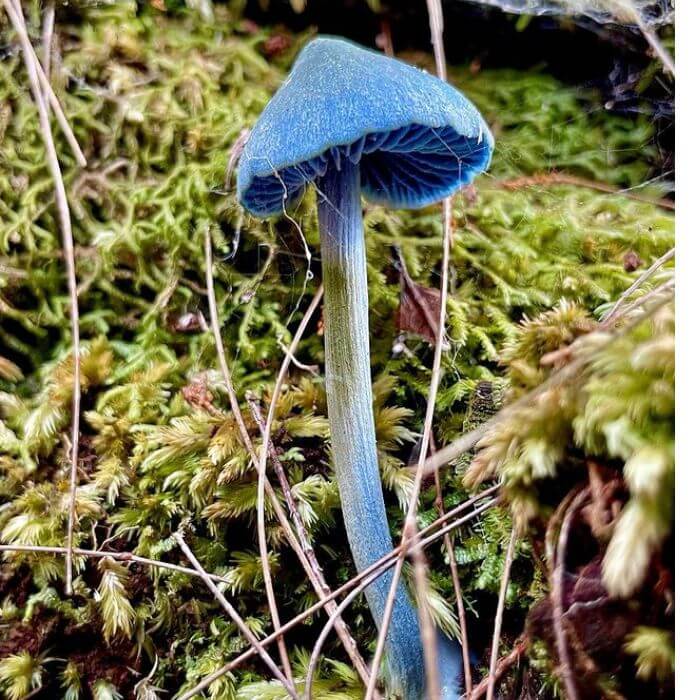
source: nature.by.jo
Entoloma hochstetteri are rare and picturesque. They occur in New Zealand and its very distinctive color ensures it stands out from its surroundings.
Identification:
Also called the sky-blue mushroom or blue pinkgill, the entoloma hochstetteri can be easily identified by its bright blue fruiting body.
Its pileus is relatively small, about 1.4 inches and is usually smooth and conical. Gills and stalks are the same color as the cap.
Note, its gills are crowded and narrowly touch the stem. The spore print of Entoloma hochstetteri is pink, giving them the blue pinkgill name.
This small blue fungus is inedible. But its beauty is unmatched!
3. Indigo Milk Cap (Lactarius Indigo)
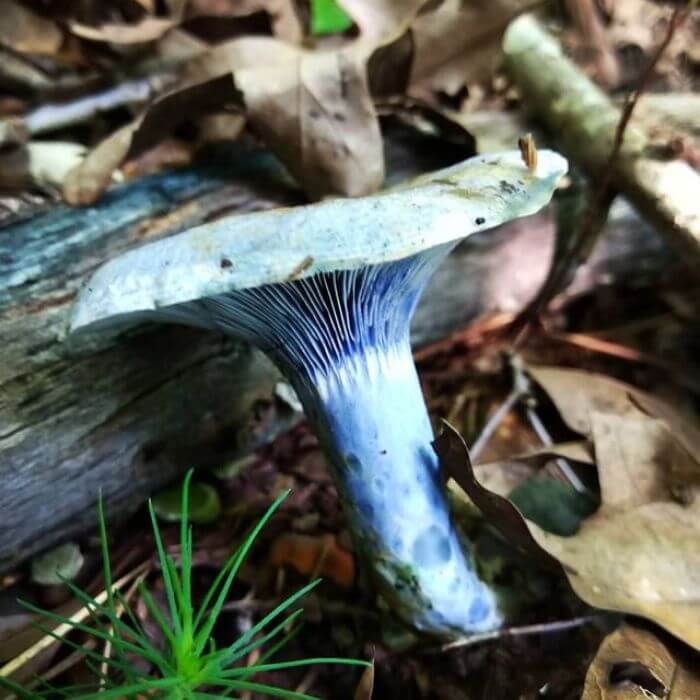
source: yarslov_
Lactarious indigo is perhaps the most popular edible blue mushroom in North America. Most mushroomers like it because it doesn’t have a look-alike, so no confusion there and cleaner compared to others like oysters.
Identification:
With its striking blue hue, they stand out from other mushrooms, making them easier to spot in their natural environment.
The indigo milk cap has a 2-6 inch dark blue convex cap and similar colored gills that are narrowly spaced. When sliced, this milk cap reveals white flesh that oozes a milky substance. The flesh turns blue-greenish quickly.
When can you find Indigo milk caps? Mostly from late August. Check around white pines. Note, they are common in eastern and southwestern. Unfortunately, this fungus does not favor PWN. The lactarius indigo does not have a unique taste.
4. Stropharia Caerulea
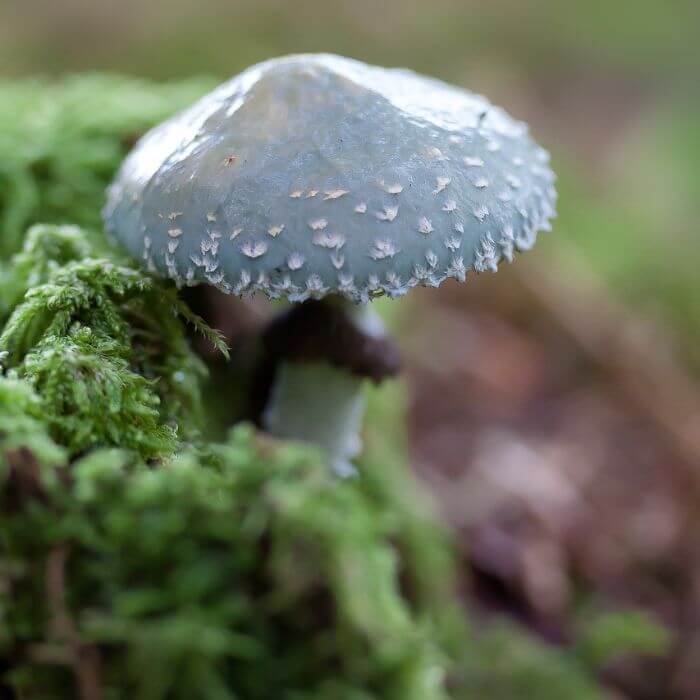
Blue roundheads or stropharia caerulea can be quite surprising. They are absolutely gorgeous and captivating.
When young, these mushrooms are so blue, making it easy to spot them growing on leaf litter or grass.
As this blue fungus ages, the canonical cap flattens and grows to 3 inches wide. It changes from blue to greenish-blue.
When rainy, the smooth cap becomes slimy and dries out in the sun. On the underside, young species have grayish gills that turn purplish-brown with age. Spore print is purple-black.
Where can you find stropharia caerulea? This blue mushroom species native to Europe and North America, popping out from August through October. Blue roundheads are inedible.
5. Blue Chanterelle
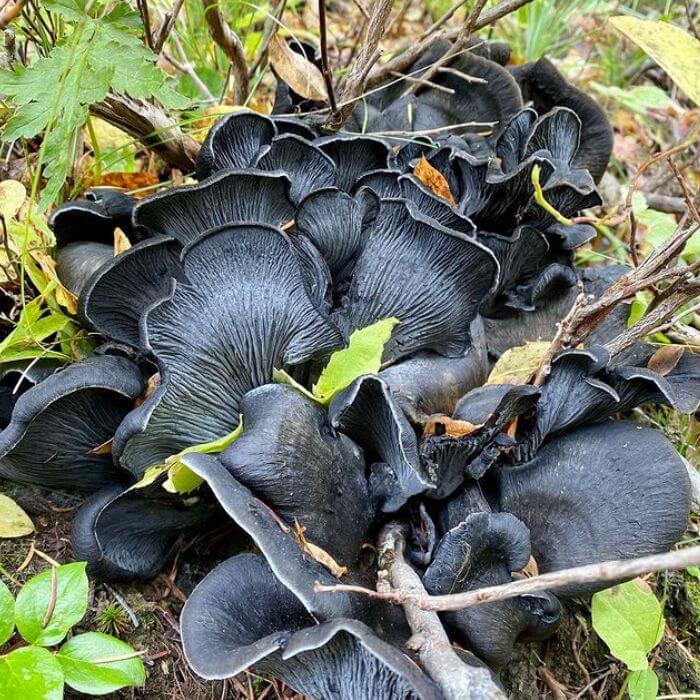
source: tinaveets
In a recent article on black fungi, we looked at the black trumpet. Blue chanterelles are closely related to black trumpets but rarer. So if you come across a cluster when fungi hunting, you’ll be one of the luckiest mushroomers.
Identification:
In some places, this mushroom is also called black chanterelle. The cap is typically funnel-shaped, and is dark blue to purplish. Their fruiting body resembles hen of the woods; caps are closely clustered.The cap is usually slightly velvety.
Its texture is a mix of hen of the woods and black trumpets; meaty and flavorful. You’ll love their tender but not slippery texture when cooked.
Like most dark colored mushrooms, this chanterelle will change the color of your food. Also it’ll stain any bright surface if left uncovered. You can store them for up to a week.
6. Mycena Interrupta
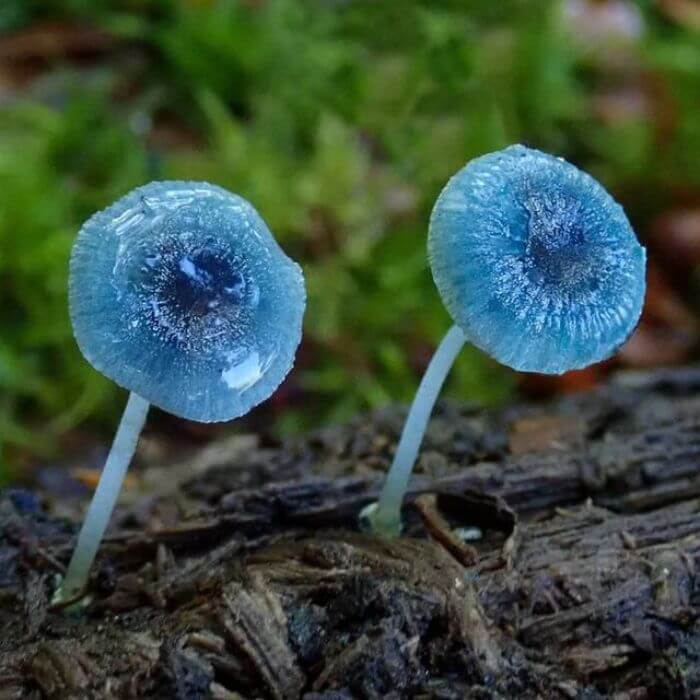
source: my_shrooms
Mycena interrupta, colloquially called pixie’s parasol, is a blue mushroom species from the mycena family. But unlike its subspecies in the family it is not bioluminescent.
Identification:
Like other mycenas, its cap is small, about 1 inch in diameter. It is usually convex or bell-shaped, and has a smooth slimy surface.
Gills are widely spaced and typically white. Stem is smooth and white. You can find these blue fungi around beech or eucalyptus. These are inedible.
7. Entoloma Medianox
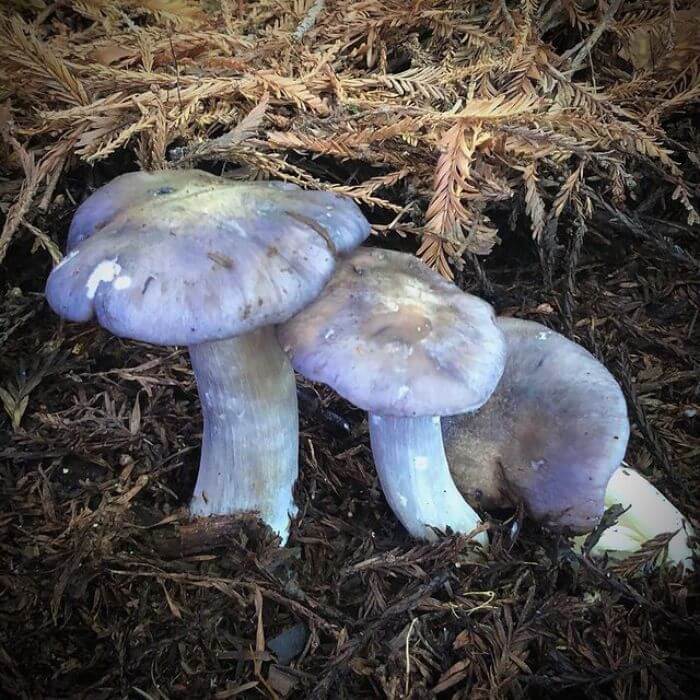
source: mushfinder
Closely related to the blue pinkgill mushrooms above, entoloma medianox is common in some western states. They are large and unmistakable.
Identification:
It is a dark blue gilled mushroom that grows in small clusters on the ground. This species can be easily identified by its large, convex cap with a streaked surface. Undercap, gills are whitish, turning blue with age. When bruised, you’ll note its white unchanging flesh.
Its stipe is thick with a tapered base. Are entoloma medianox edible? Yes, these versatile mushrooms are edible.
8. Blue Foot Mushrooms
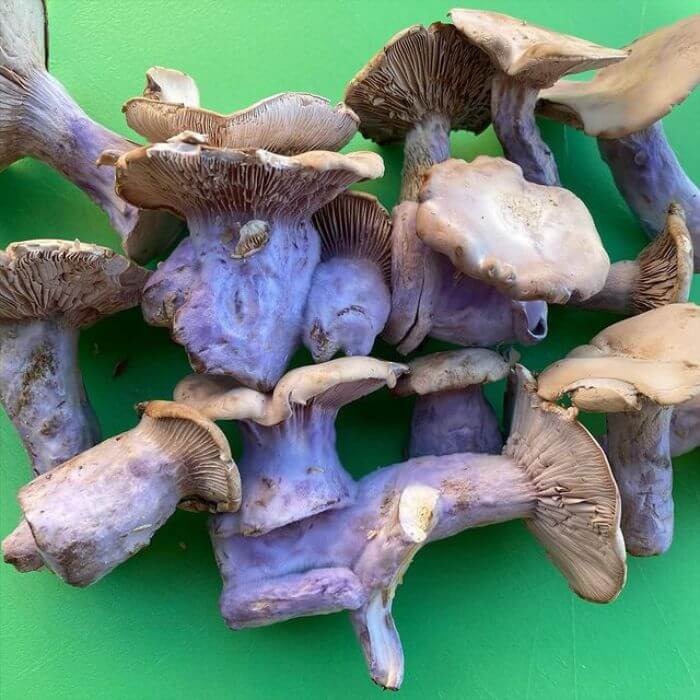
source: antonioventresco
Blue foot mushrooms, also known as the bleeding blue tooth fungi, are an interesting member of the tooth fungi family. It’s closely related to the gorgeous devil’s tooth fungus.
Identification:
They are very rare. Their irregular caps range from 1.6-3 inches with a wavy or lobed margin. The surface is rough. In young species you’ll notice bloody red liquid on the surface.
Underside of the large caps there are small spines instead of gills. Its flesh is typically bluish. Bleeding blue tooth fungi are inedible. But if you are into nature photography, these mushrooms are picturesque
9. Cortinarius Rotundisporus
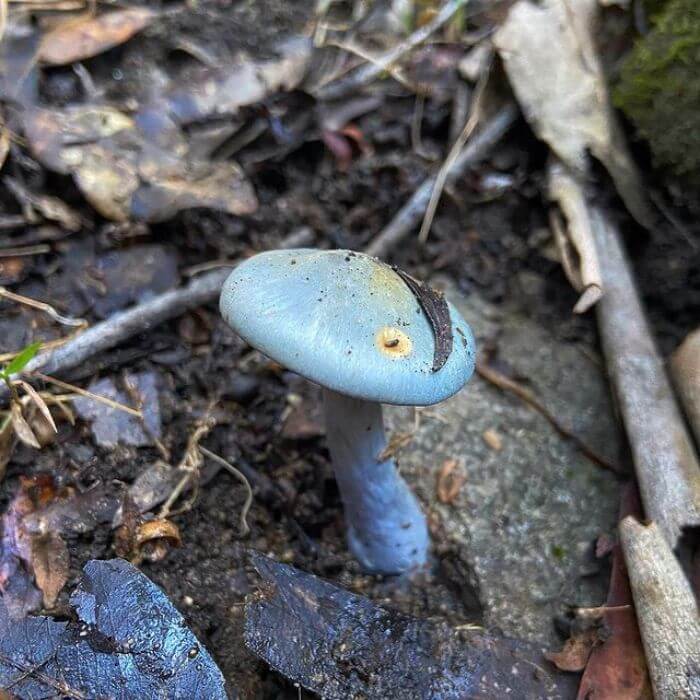
source: sabinetramaseur
Elegant blue webcaps or the cortinarius rotundisporus occur in Australia.
Identification:
Its cap grows to about 3 inches. It starts out convex shaped, becomes flat and eventually up turned on its last days. The blue hue also fades with time and its center becomes yellowish. Its adnate gills are creamish in young species turning brownish with age.
The spore print is rust-brown.
10. Coprinopsis Pulchricaerulea
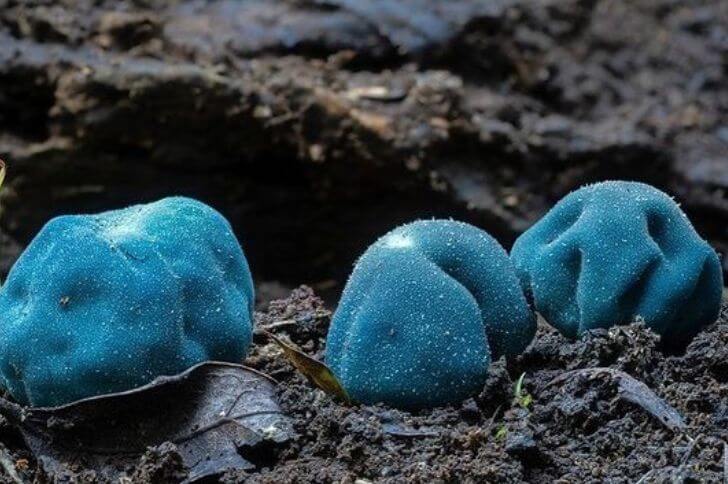
source: plantsnap
Coprinopsis pulchricaerulea is a species of mushroom belonging to the Coprinopsis genus, which is part of the Psathyrellaceae family.
Identification:
This type of mushroom has a striking blue-purple coloration making it stand out among its peers.
The caps are typically no more than 2 inches wide with a gorgeous sky blue hue. On the underside the gills are white, turning pale tan with age. Note, the cap is usually convex but sometimes can become deformed giving it a stunning appearance.
Its stalk is short and whitish with a bulbous base. Where can you find coprinopsis pulchricaerulea? They occur in small groups in Australia.
11. Clitocybe Odora
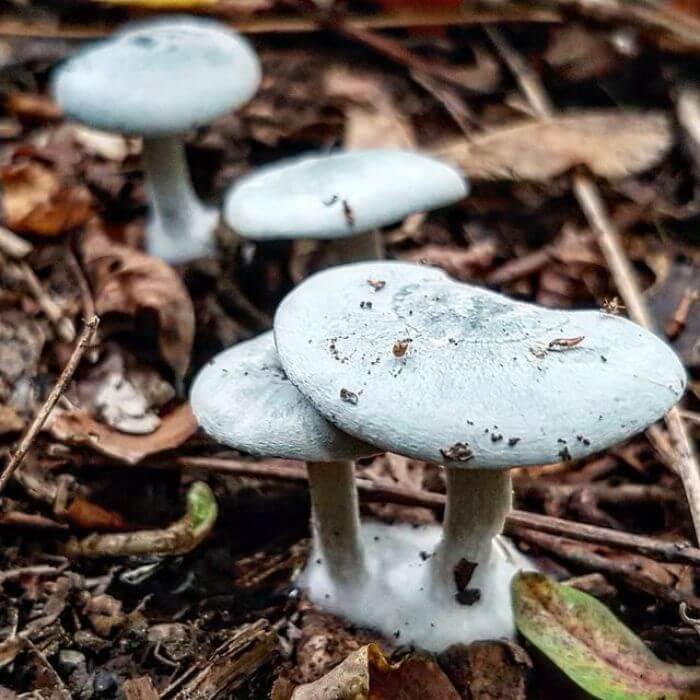
source: barbara_gerald1
Clitocybe odora, also known as the aniseed funnel, is a fungal species of the Tricholomataceae family.
Identification:
It is a unique mushroom with an intensely sweet smell of anise and licorice in its raw form. These mushrooms are visually appealing. Their scientific name, clitocybe odura , describes them perfectly; clitocybe means depressed and odora means fragrant.
Young aniseeds have a convex shaped pileus with incurved margins. With time, the caps flatten and on their last days the center becomes depressed, giving them a funnel shape. The color of the cap starts blue-greenish, becoming brownish with age.
They have white gills and a white spore print. This species has been widely used for culinary purposes due to its flavor; it is usually cooked before being eaten.
12. Chlorociboria Aeruginascens
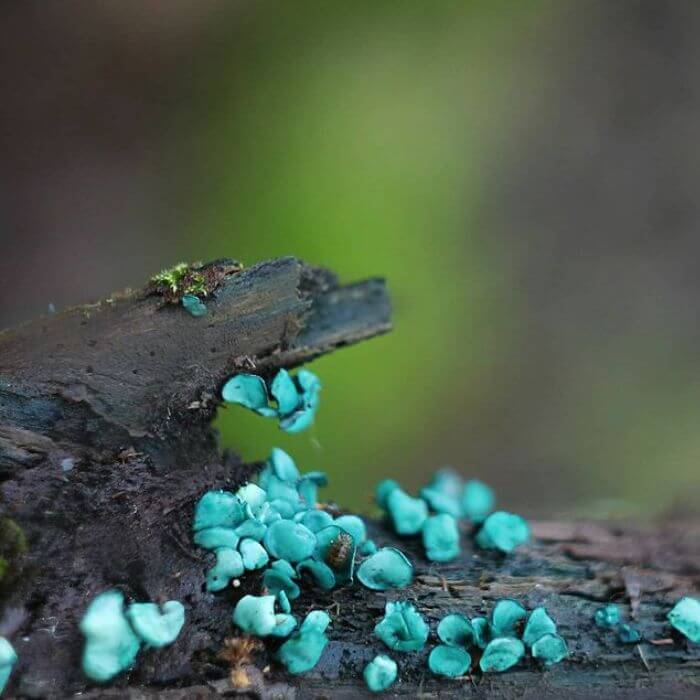
source:olya95photo
Chlorociboria aeruginascens, commonly known as green wood cup or green elfcup, is a small, colorful fungus found growing on deadwood.
Identification:
This species of green-staining fungi received its name from its blue-green colored spores which can stain various surfaces upon contact.
Chlorociboria aeruginascens typically grows as a thin, crust-like layer on dead or dying wood. The fruiting body is very small, only a few millimeters in size, and is cup-shaped or saucer-shaped.
The fruiting body of this small fungus is typically a pale blue-green or turquoise color, which is what gives the stained wood its distinctive hue.
Though it may be small in size, Chlorociboria aeruginascens plays an important role in nature. In addition to providing sustenance for insects and other organisms in the process of decomposition. Furthermore, its visually pleasing colors add aesthetic value to the surrounding environment.
13. Stropharia Aeruginosa
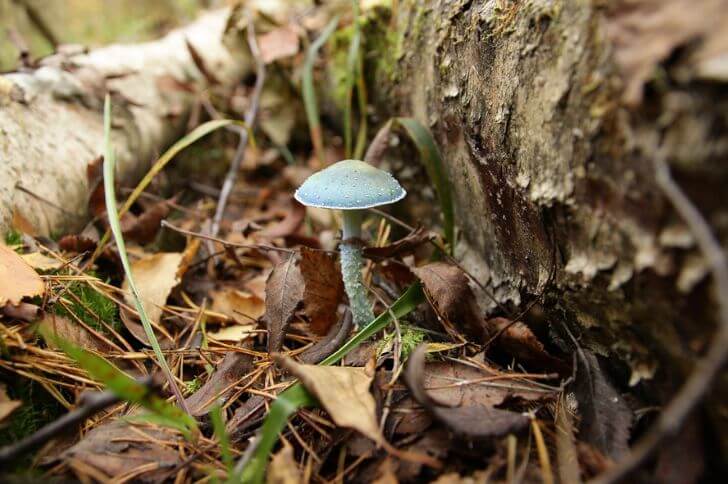
Often confused for the blue roundhead above, the stropharia aeruginosa or verdigris agaric is a blue fungus that is found in some regions of North America and Europe.
Identification:
It can be found in grassy areas. Stropharia aeruginosa is bluish-green in appearance with bell-shaped caps in the beginning becoming almost flat in maturity. Like the fly agarics, young verdigris agarics have whitish spots. The stem is rather sturdy with white scales.
FAQs
Can you eat blue indigo mushrooms?
The answer is yes, you can. With the proper precautions taken and given their natural low toxicity level, blue indigo mushrooms make for a delicious addition to any meal.
The best way to eat them is to first cook the mushrooms thoroughly. Additionally, consuming the mushroom in small amounts at first is recommended.
Overall, blue indigo mushrooms can be considered edible given they are prepared properly and consumed in moderate amounts.
What do blue mushrooms taste like?
According to most foragers they taste like portobello. They’ve described their texture as grainy.
What edible boletus turns blue?
Cyanoboletus pulverulentus are brown and yellow and stain blue when bruised or sliced. Like other boletes, they have yellow spores instead of gills. They are edible but because they grow singly, you may have a hard time collecting enough.
Is blue mushroom edible?
Edible blue fungi include indigo milk caps, clitocybe odora, blue oyster mushrooms and blue chanterelles.
Sources:
Hi There,
My name is Jenny. I’m the Chief Editor at Try Green Recipes and besides making yummy and healthy foods for my kids, grandkids, and friends. I’m new to the blogging world but I believe what I have to share is unique and will bring joy to your home. If you are adventurous and want try something tasty, let’s get started.

